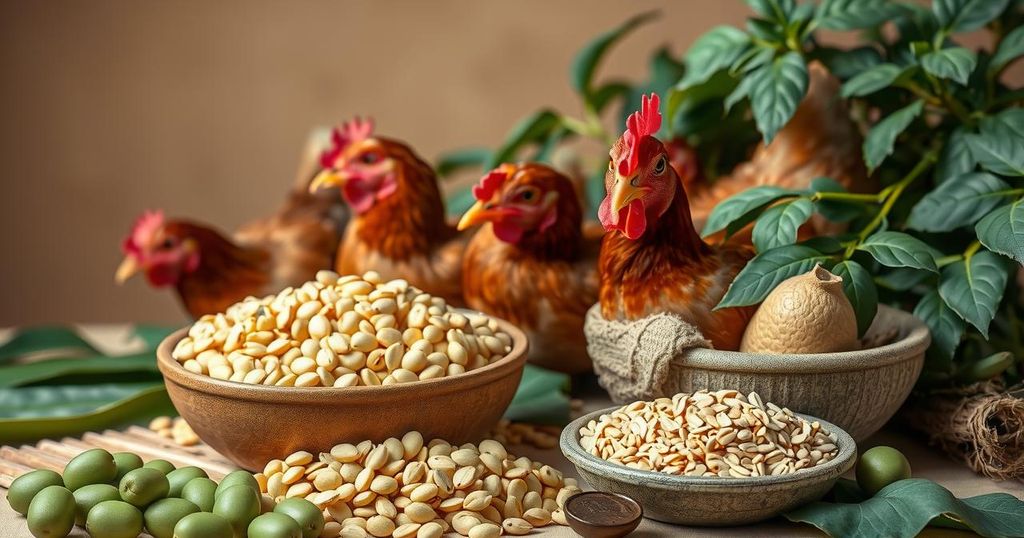Zambia and Malawi are crucial soybean producers for poultry feed, yet rising soybean prices along with climate impacts have threatened poultry production. Small producers bear the brunt of high feed costs, with market concentration exacerbating price fluctuations. Malawi’s prices soared despite sufficient production, while Zambia’s prices moderated due to imports. Addressing competition issues is vital for the sustainable growth of the poultry industry as demand rises in Sub-Saharan Africa.
Zambia and Malawi play significant roles in soybean production in eastern and southern Africa, particularly as soybeans are a crucial component of poultry feed. The region relies heavily on poultry as an affordable protein source, making soybean pricing essential for food security. However, recent challenges in soybean production and pricing have raised concerns regarding the poultry industry, threatening its competitiveness and affordability for consumers.
In recent years, soybean prices in both Zambia and Malawi have risen drastically, particularly in 2024 when severe climate change impacts affected crop yields. In Zambia, soybean production plummeted by 74% due to unfavorable weather conditions, coupled with low purchase prices negotiated by large soybean buyers. Malawi experienced a 20% decline in production, but its soybean prices surged by 48%, surpassing those in Zambia.
The high cost of poultry feed, which constitutes 60% to 70% of total poultry production costs, is critically influenced by soybean prices. Small-scale poultry producers in these nations struggle with high feed prices due to their dependence on open market purchases, limiting their ability to remain competitive against larger producers who can manage feed sourcing better.
Market dynamics additionally indicate that market concentration and limited competition exacerbate price fluctuations, negatively impacting small producers. Reports from the African Market Observatory reveal that large buyers exert significant influence over prices paid to farmers, resulting in unfavorable trading conditions for those smaller operations.
Examining production trends, Zambia’s soybean output burgeoned from 297,000 tonnes in 2020 to 650,000 tonnes by 2023, but the 2024 collapse due to adverse conditions reinforces the vulnerability of the sector. Immediate factors contributing to this disruption included severe drought and reduced planting motivated by low prices offered by processors.
Furthermore, substantial disparities in soybean prices were noted, with Malawi seeing prices rise sharply, peaking over $900 per tonne by the end of 2024 despite its capacity to produce sufficient soybeans for local consumption. Price control measures by the Malawian government, along with export restrictions, have not curbed the escalating prices attributable to concentrated trading practices.
In contrast, Zambia benefited from moderated soybean prices due to importations and increased stock from prior crushing operations. Nonetheless, the continued analysis of competition and pricing mechanisms in soybean markets is vital in ensuring the resilience of the poultry sector in both Zambia and Malawi as well as meeting the increasing demand for poultry in Sub-Saharan Africa.
To combat these challenges, a regional approach towards monitoring market dynamics and fostering competitive practices is essential. This would provide small producers with the necessary support to thrive in an evolving market environment while addressing the pressing issue of food security in the region.
The situation surrounding soybean production and pricing in Zambia and Malawi underscores the intricate link between agricultural dynamics and food security in eastern and southern Africa. High soybean prices significantly affect poultry production costs, placing strain on small producers while reducing market competitiveness. As demands for poultry protein rise, particularly in the region, the resolution of competition issues and the implementation of supportive measures are imperative to ensure sustainable food production. A concerted regional effort is necessary to address underlying market concentration and promote equitable trading conditions for all producers.
Original Source: theconversation.com




